What is sales enablement and how does it work?

In the span of a few years, sales enablement technology has evolved from niche to “nice to have” to essential to the sales process and tech stack, according to Gartner.
Now, “80% of sellers who reached 150% of quota or more use sales tech at least once a week” (LinkedIn State of Sales Report 2022 United States & Canada Edition).
But what does “sales enablement” really mean for you and your organization? When does it need to be a priority? And who owns it?
These are some of the many great questions about sales enablement this guide answers. It paints a clear and comprehensive picture of how sales enablement applies to modern businesses and how yours can get started, starting with the basics.
What is sales enablement?
Sales enablement is:
a strategic, cross-functional discipline designed to increase sales results and productivity by providing integrated content, training, and coaching services for salespeople and front-line sales managers along the entire customer’s buying journey, powered by technology.
That definition comes from research firm CSO Insights. One of the reasons we’re partial to it here at Brainshark is that it includes the most common responsibilities and “services” provided by sales enablement teams today, while also emphasizing the role technology plays in making it all happen.
While sales enablement is still the most commonly used term for the technology and processes that definition describes, you may also encounter the terms “revenue enablement” and “go-to-market enablement” — especially as the industry evolves.
In fact, Gartner’s latest report declared revenue enablement to be the predominant term. This latest change is due to how enablement methods and capabilities have expanded beyond sales and marketing to include all revenue-generating and customer-facing roles. See the figure below, taken from The 2022 Gartner® Market Guide for Revenue Enablement Platforms.
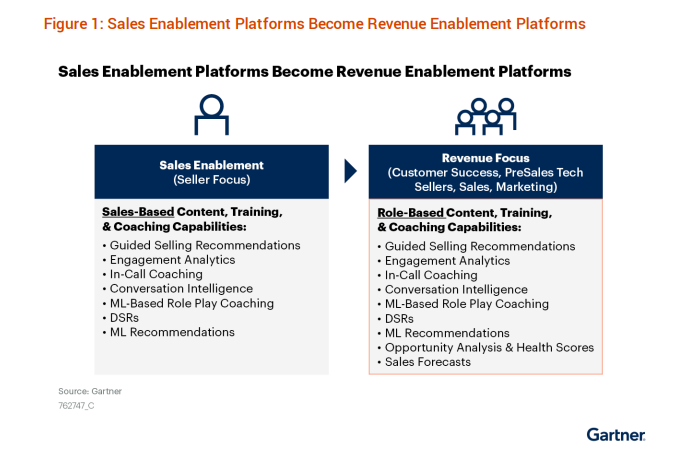
Of course, how you define sales enablement often depends on who you ask. Different companies have different views on what it means, how to approach it, and how the function is staffed – which leads us to another common question.
Find more definitions and industry history in this guide to acquiring more buyers and keeping your best customers.
What do sales enablement teams do?
Sales enablement teams can handle a wide range of different activities and priorities, including:
- Sales onboarding and continuous learning programs
- Creation of sales assets and sales training content
- Ownership and implementation of the sales coaching strategy
- Sales communications
- Cross-functional communication
- Management of sales tools and user best practices
- Measuring and reporting on sales enablement program success
- Planning and executing sales kickoff events

Pictured: Sales reps playing an augmented reality game planned by our enablement team at our 2022 sales kickoff
Any or all of these areas could fall under sales enablement, depending on company size and industry, the needs of the sales force, and enablement team structure.
As for who owns sales enablement? Almost 50% of sales enablement functions sit under the head of sales, according to CSO Insights, while others might report into executive management, sales operations, or marketing.
Some firms may only have one person who is responsible for enabling the entire organization on a full- or part-time basis. Others may have multiple dedicated practitioners who are each focused on a piece of the sales enablement strategy (such as a dedicated sales coach or content creation specialist).
Ultimately, every sales enablement team still exists to support sellers. How each company accomplishes that tends to look a little different.
Why is sales enablement important?
For starters, sales enablement helps companies achieve better results! What could be more important than that?
Sales enablement leads to 15% better win rates and it’s also correlated with more effective sales training, stronger customer relationships, and higher quota attainment (source: CSO Insights).
There are many other benefits of sales enablement, too. A few big ones to know are:
- Sales readiness
Sales readiness is a core component of sales enablement, where the goal is ensuring salespeople have the knowledge and skills to maximize every client interaction.
Readiness involves all the strategic activities that prepare reps to sell, such as onboarding, coaching, continuous learning and reinforcement, and covers everything a rep might need to know on the job: product details, messaging, competitive positioning, and the many skills needed to have valuable interactions throughout the sales process.
Done right, buyers will leave calls and meetings thinking their time with your reps was well-spent – even if it doesn’t end with a closed deal.
- Sales engagement and retention
Sales enablement exists to help reps succeed. And when reps can produce better results, they’re more likely to be engaged with their jobs and stick around at your company long term.
Don’t believe us? Forrester reported that high-performing sales organizations provide more continuous learning, peer learning, and advanced skills training than low-performing teams.
This extends not only to sales reps, but also to sales managers. Equipping front-line managers to support reps with good coaching and communication skills improves seller engagement and leads to better results.
“How your sales managers inspire, motivate, and engage your sales teams is the single most important practice to drive seller engagement.” – CSO Insights
- Client-facing success
Quota-carrying sales reps aren’t the only ones who need support — everyone who directly faces your buyers will also benefit from relevant content, training, and coaching. This includes everyone from sales engineers and customer success, to service teams and channel partners.
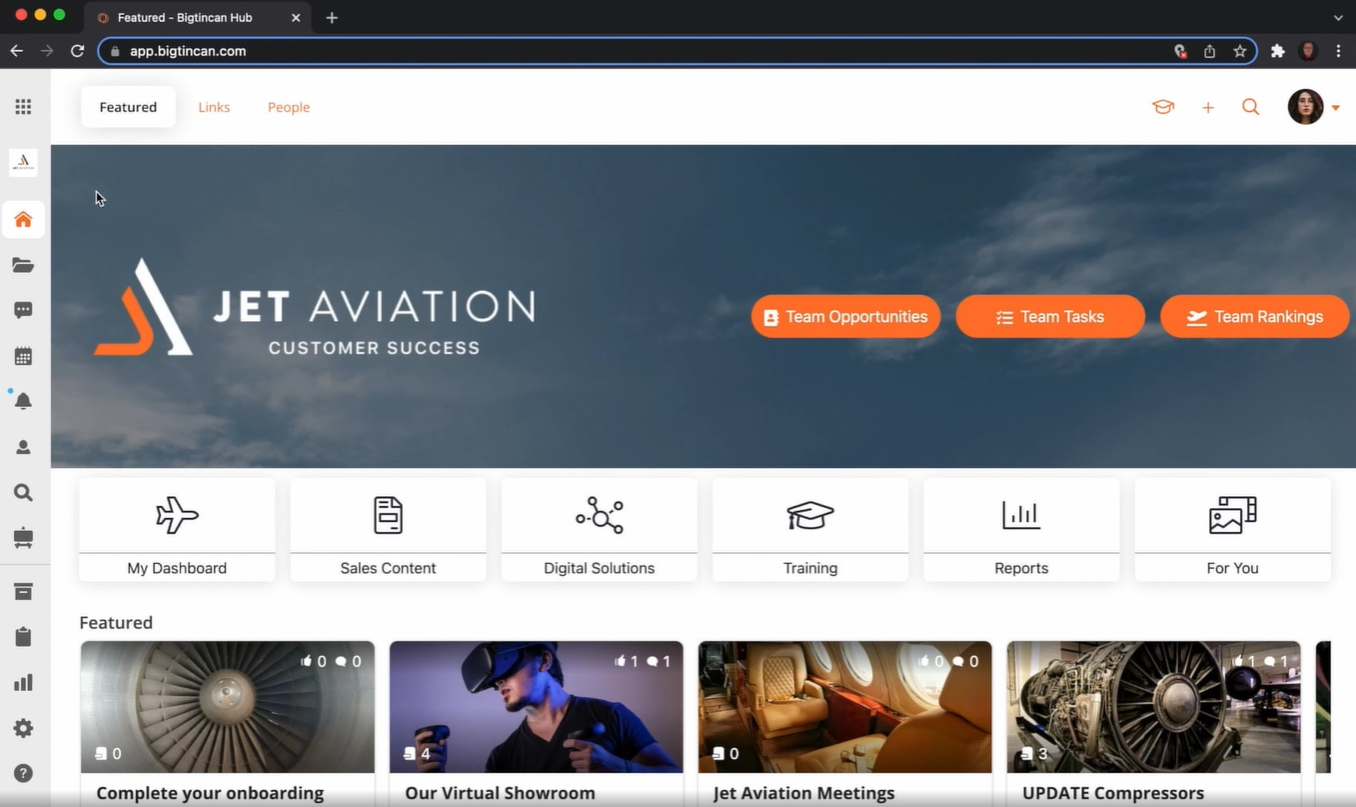
Pictured: Bigtincan Content Hub branded for the Jet Aviation customer success team
When it comes to channel sellers, for instance, B2B organizations need a way to keep external reps engaged with your messaging and driving revenue for your brand, instead of a rival company.
- Effective usage of sales tools
Sales reps might use several different tools on a given day. There are CRMs, sales enablement tools, engagement tools, intelligence tools, communication tools, and MANY more. Some of these tools represent major investments for the company, so it makes sense that you’d want someone to ensure reps know how to use all this technology – and use it well.
CSO Insights reports that sales tool usage is the 2nd-most common priority of sales enablement teams today. Sales enablement works with vendor CSM teams when new releases come out, provides related training, and makes sure sellers can make the most of their resources. With the right preparation, reps can even turn their sales tools into a differentiator for your company.
When do you need sales enablement?
We’ve covered the “what” and the “why” of sales enablement. But you might be wondering whether your organization should build out a sales enablement program – or expand an existing one.
Here are a few important questions to ask, as suggested by Bigtincan/Brainshark’s own Director of Sales Enablement, Beverlie Heyman:
- Are we meeting all our sales goals?
- Are we confident reps are always on-message?’
- Are we 100% sure reps are using sales tools to their fullest extent?
- Is there no room to improve seller quota attainment?
If you answered ‘no’ to any of the following questions, then your organization could definitely use sales enablement.
And even if you answered ‘yes’ across the board, it’s important to remember that businesses change all the time. Maybe you have a growing sales force that needs a more formal onboarding process. Maybe your reps sell a rapidly-changing product or service, and the buying process has become more complex. You could have significant messaging changes related to M&A or a new go-to-market strategy.
These are challenges that will affect most companies at one point or another.
In each of these cases, enablement is critical to sustaining any sales success you’re seeing today.
Gaining buy-in for sales enablement
Let’s say you’ve decided you’re ready to create a sales enablement program. That’s a great first step!
However, just because you see the value of sales enablement doesn’t mean your sales leaders or executives do. And without their support, you’ll have a hard time achieving results – especially if you’re just getting started.
That’s why you need to build a compelling sales enablement business case before pitching senior leaders on a new program. To do this, you’ll want to keep a few key pointers in mind:
- Assess your organization’s needs
While this may seem obvious, you need to define what sales enablement will try to accomplish and which problems it will solve. Setting clear goals will help you focus your budget requests and prevent you from trying to “boil the ocean” with finite resources.
For example, if sellers are underperforming, partner with sales ops to better understand why that’s the case. Maybe you analyze the sales funnel and find a high number of lost or stalled deals in the discovery phase. Maybe you also see Year 1 sellers struggling to close their first deals quickly. That data already gives you two major priorities: discovery training and new hire onboarding.
- Document your strategy
Once you know what you’re solving for, then you can start planning the solution. A sales enablement charter puts your business plan in writing so you can present it to the executive team for sign-off. The charter should define what your program is responsible for, how you might staff it, which audiences you’ll serve, key investments, and how you’ll measure success (i.e. metrics).
- Speak the language of your decision-makers
In sales, reps need to be aware of how their buyers communicate. The same goes for “selling” an enablement program internally. Once you’ve crafted your charter, you need to present it in a way that persuades your leadership team to really care.
To do this, communicate your proposed initiatives in a clear, concise way, and tie the story to their business goals.
If the CEO is prioritizing customer retention rates, then make sure one of sales enablement’s goals will be working with account managers on the renewal process.
When you’re speaking with the CFO, frame your pitch around the financial impact of the program. If reducing time to productivity is a goal, for instance, explain how that would increase the number of deals a new sales hire closes.
- Gain support of reps and front-line managers
Change management requires support from multiple people when it comes to sales enablement, including reps and their managers. To make this happen, you need to understand their realities at work and position enablement around “what’s in it for them.”
For instance, when you directly tie enablement to how sellers achieve quota, you’ll get their attention. Try capturing an early success story – such as a rep who won new business thanks to enablement-led coaching – and share it as a success blueprint that peers can follow.
Sales managers, meanwhile, need to be in lockstep with your strategy. After all, they’re in the room with reps when your sales enablement team isn’t. Make consistent communication and alignment with front-line leaders a priority when rolling out new initiatives.
- Related content: The Business Case and Playbook for Data-Driven Sales Coaching
Key sales enablement terms defined
Whether you’re new to your role or you’re looking to expand your sales enablement knowledge, it helps to have a well-rounded understanding of the practice. Below is a brief glossary of terms worth knowing.
Sales training
Sales training, including both new hire onboarding and continuous learning, is how you help reps build new skills, behaviors, or knowledge. The learning can cover any number of different topics – from product knowledge and buyer personas to effective writing and communication skills – and come in a variety of formats, such as eLearning, live sessions, or online simulation.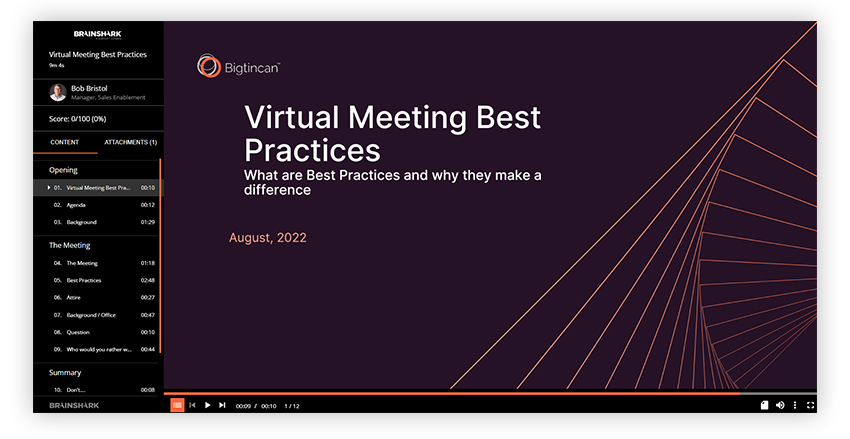
Sales training is typically either led by an in-house expert – such as the sales enablement team or a designated sales manager – or outsourced to an external consultant.
Sales coaching
Sales coaching is the process of evaluating reps’ skills, knowledge and readiness, and providing feedback for continuous improvement in performance. This process is often led by sales managers and facilitated by sales enablement professionals.
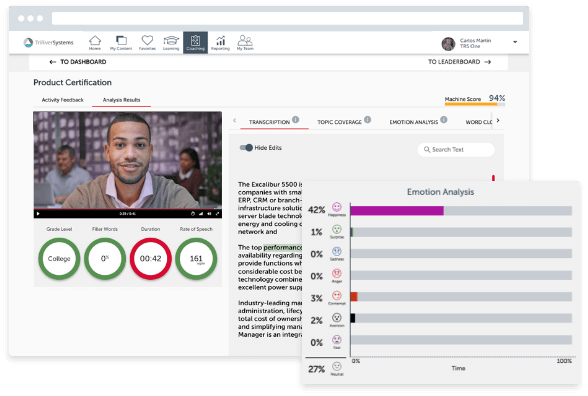
Many companies provide in-person coaching (i.e. sales role plays) where managers might define certain scenarios and see how reps handle it in a simulated environment. Increasingly, firms also rely on video coaching activities, where reps “stand and deliver” what they’ve learned on video and submit the recording to peers or a manager for feedback.
Sales coaching assessments
A company probably knows whether its sellers have completed required training courses. But once reps start engaging with buyers, can they take what they’ve learned and apply it in the field? (In other words, ‘did they do it?’ versus ‘can they do it?’) Sales coaching assessments are all about answering this question, and they exist in a few different formats.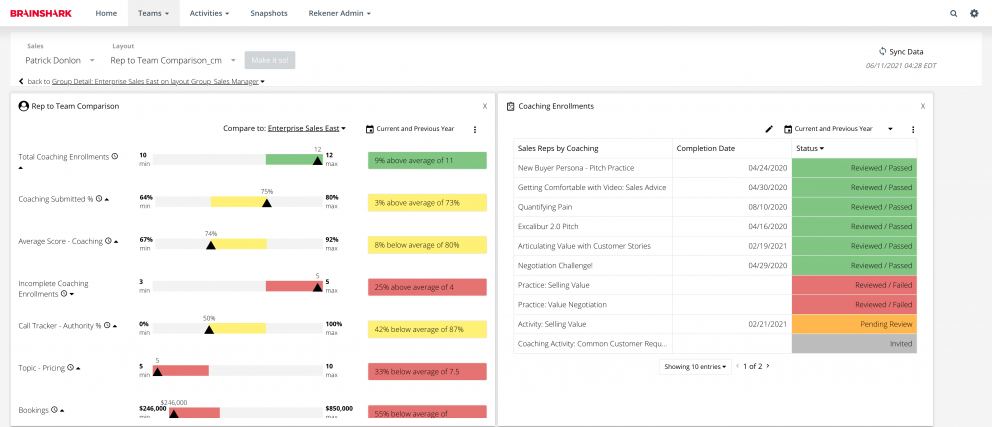
There are knowledge-checks, such as a quiz or exam that tests for learning comprehension. There are simulation assessments, where reps practice what they’ve learned in a safe environment and receive feedback. A simulation could be an in-person role play exercise, or a virtual coaching activity where reps record themselves delivering key messaging to a hypothetical buyer. Finally, there’s in-field observation – such as a ride-along – to ensure reps can “put it all together” in front of buyers.
Sales enablement tools
A sales enablement tool is any piece of technology that supports a more effective or efficient sales process, with the goal of helping sales teams achieve their corporate objectives. They exist to make life easier for anyone who works in, or with, the sales organization.
There are several different types of sales enablement technology on the market today, such as video coaching tools, sales content management tools, sales intelligence – just to name a few.
Sales effectiveness
Sales effectiveness is the result of a well-executed sales enablement and readiness strategy. An effective sales force is one with reps who are equipped to excel at each stage of the buyer’s journey.
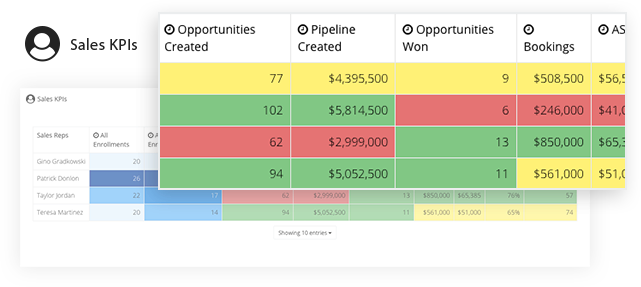
Some larger companies might also have a formal “sales effectiveness” function, which has responsibilities that might otherwise fall under a sales enablement or a sales ops team. (For example, data- and coaching-related sales manager enablement.)
Sales content
Sales content is any asset that primarily exists to help reps close new business. This includes external-facing content meant to persuade buyers – such as a product sheet or case study – but it also includes internal-use content that keeps reps prepared, like messaging guides and battle cards.
More sales enablement resources to bookmark
Hopefully this guide gave you a better understanding of sales enablement.
Of course, learning never stops. Be sure to bookmark this page so you can come back to it.
If you’re still seeking knowledge, we’ve included links to useful professional forums, blogs, research, and other free enablement guides.
Browse them at your convenience and let us know if there’s anything we’ve missed!

